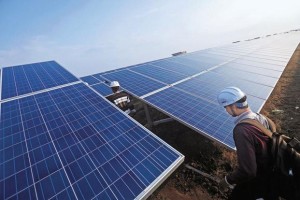
India turned a new leaf on 1 February 2017 by announcing the Budget 2017, a departure from practice of announcing it on Feb end. So has the new budget helped the solar power industry. Lets find out.
First the Positives
The Finance Minister Arun Jaitley announced a slew of measures that are expected to have long term effect on the solar power industry in India not only in 2017 but perhaps also beyond.
- 7,000 railway stations will be powered by solar power in the medium term. After selecting 300 stations in first state work on which are going on (including 4 railway stations of NCR that were won by Vivaan Solar) 2,000 more railway stations as part of 1000 MW solar mission.
- In the second phase of Solar Park development capacity to be added is 20,000 MW.
- Countervailing Duty (CVD) reduced to NIL from 5% on solar tempered glass for use in manufacturing solar cells/panels/modules.
- BCD on Parts/raw materials for use in making solar tempered glass used in solar pv cells/modules, solar power generating equipment or systems, flat plate solar collector, solar pv module and panel for water pumping and other applications, subject to actual user condition cut to 6% from 12.5%.
What Indian Solar Industry Needed from Budget 2017
All these steps are expected to further pull down the cost of setting up solar park and as a result the cost of solar power may well break the INR Rs 4 / unit price.What Indian Solar Industry Needed from Budget 2017.
According to estimates solar power alone will need funds for upto US$100 billion in debts to reach 100 GW power generation capacity out of the 175 GW that is envisaged under National Solar Mission by 2022. The financial needs are mammoth and India must look beyond fiscal allocations international debt markets estimated at US$95 trillion, are the world’s largest pool of capital and need to be accessed to generate solar power at affordable cost. Compared to last year (INR Rs5,036 crore), this year allocation to MNRE is INR Rs5,473 crore a slight increase but 74% of it is directed to grid connected solar park development to kick start the second phase of solar park development for 20 GW of capacity. With INR Rs3,361 crore year marked for solar it indicates the government will continue to focus on solar power.
An uncertainty over how Goods and Services Tax (GST) will impact solar power is also there. As solar components were categorized on current levied tax rates (including exemptions and subsidies), GST will have little impact on solar tariffs. However, if preferential tax benefits to renewable energy are not counted, then GST could impact utility scale solar tariffs by upto 9.5% hampering progress.
Hits and Misses for Solar Power in Budget 2017
It was a case of many hits and misses. Firstly, residential rooftop solar projects could create 15 GW of renewable energy capacity by 2022 but no direct support was announced for rooftop solar. Secondly, replacing nearly 15% of India’s irrigation pumps with solar powered pumps could create as much as 20 GW of capacity in four years, the 2017 budget has proposed to interlink Primary Agriculture Credit Societies with District Central Cooperative Banks. This may increase access to low-cost loans for setting up solar pumps.
The 2017 budget has not taken into account high capital costs, long payback periods, foreign exchange risks. CEEW research shows 70% of costs embedded in already low solar tariffs are bcoz of return on equity and debt servicing. But no budgetary support was extended to address risks. Even financial support for Solar Energy Corporation of India, has been halved to Rs50 crore. Even focus on research and development was curtailed as only INR Rs144 crore was been budgeted for research and development, a drop of nearly 50% from last year.
Future of Solar Energy in India in 2017
A UN report says India’s plan to ramp up solar power to 100 GW by 2022 is the largest in the world. The World Bank is helping India deliver on its plans with more than US$1 billion lending in 2017. This is the Bank’s largest-ever support for solar power in any country.

Indian Railways has said it has finalised a policy for harnessing solar energy on rooftops of railway premises. The policy provided for setting up solar power plants through longterm Power Purchase Agreement (PPA) by railways. By expanding use of solar power as part of the National Solar Mission, the Indian Railways wants to proportionately cut consumption of fossil fuels. In 2017 India will build a pipeline of 14 GW of utility scale solar projects, of which 7.7 GW are expected to be commissioned in 2017. According to Bridge to India combined with 1.1 GW of expected rooftop solar capacity, India will add 8.8 GW in 2017, ranking India 3rd after China and the USA.
In villages where regular power is scarce solar energy should be promoted as the ultimate means and made available at minimum costs, reducing dependence on conventional power sources. Not surprisingly big cities are harnessing solar power for various household and industrial uses, which can and should be taken up on a larger scale to make it a economically viable option. People should be given more tax incentives for reducing use of energy with purchase of energy-efficient appliances in households, residential buildings and commercial setup. As solar energy has been central to the government’s renewable energy plans, Power and Energy Minister Piyush Goyal has indicated that rooftop solar will receive further tax breaks.
While the real impact of the policies announced will be most likely felt by the end of 1st qjuarter 2017, what is comforting is that the government is steadfast in its quest towards achieving the target of 100 GW under National Solar Mission by 2022, Eventhough this years budget was not as expected lets’ hope the momentum is not lost and the Budget 2018 next year makes up for the shortfall this year.
About Vivaan Solar
Vivaan Solar as a EPC contractor is a solar PhotoVoltaic system installer & integrator. We have installed 60 MW solar park in Madhya Pradesh, 5 MW in Punjab, 8 MW in Uttarakhand and an upcoming park in Karnataka. We are also MNRE accredited channel partner for Rooftop. We have done turnkey works for multiple companies across the country and has third party agreements with some of the leading industries/commercial institutions across the state.
Sources
http://www.firstpost.com/business/budget-2017-support-for-renewable-energy-minuscule-why-cos-may-be-unhappy-3243038.html
http://www.livemint.com/Industry/jmeTMQYkdO9HHoktcPSSgK/Union-Budget-2017-Arun-Jaitley-focuses-on-clean-power-ener.html
http://www.dnaindia.com/money/report-budget-2017-reduces-tax-obligation-for-renewable-energy-sector-2306232
http://www.eqmagpro.com/india-budget-2017-2018-whats-in-it-for-renewable


Nice article..!
“We are India’s leading integrated solar energy solutions company providing innovative solar power solutions for residential and commercial needs. Our team of expert technicians and engineers are driven by the vision of clean energy and a green planet.”
Visit : http://www.brihat.in/solutions/solar-power-solutions/
dear
sir/madam
Thanks for the appreciation for writing the blog and do spread the word about our blog.
We do like to share useful information on solar power and renewable energy and technology and add our perspective and please share the info with your friends.
Keep watching this space for the latest blog updates and do watch our social media profile.
Thanks for sharing this article.i love this post…keep posting on it…its very beneficial for all of us.
mainly i think Conventional hydroelectricity works very well in conjunction with variable electricity sources such as solar and wind, the water can be held back and allowed to flow as required. Where a suitable river is not available, pumped-storage hydroelectricity stores energy in the form of water pumped when surplus electricity is available, from a lower elevation reservoir to a higher elevation one.
dear
sir/madam
We really appreciate your input,
Thanks for the appreciation for writing the blog and do spread the word about our blog.
We do like to share useful information on solar power and renewable energy and technology and add our perspective and please share the info with your friends.
Keep watching this space for the latest blog updates and do watch our social media profile.
Asterixenergy is one of the leading solar panel manufacturers in India. They offer the service of Solar Panel Mounting Structure based on the type of building. They can mount solar panels on all type o roof top
sir/madam
Thanks for the appreciation for writing the blog and do spread the word about our blog.
We do like to share useful information on solar power and renewable energy and technology and add our perspective and please share the info with your friends.
Keep watching this space for the latest blog updates and do watch our social media profile.
amazing article
dear
sir/madam
Thanks for the appreciation for writing the blog and do spread the word about our blog.
We do like to share useful information on solar power and renewable energy and technology and add our perspective and please share the info with your friends.
Keep watching this space for the latest blog updates and do watch our social media profile.